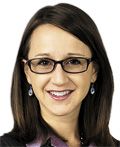Bridging the online pharmacy knowledge gap
A majority of pharmacists don’t talk to patients about online pharmacies.
A majority of pharmacists don’t talk to patients about online pharmacies – especially those that sell counterfeit drugs – according to a recent survey.
Forty-five percent of pharmacists and other healthcare providers who took a free online continuing pharmacy education course, “Internet Drug Sellers: What Providers Need to Know,” said they “never” or “almost never” discuss online drug sellers with their patients. Only 6% reported that they make a consistent effort to talk about the issue, and only 1% said they do so regularly.

Libby Baney“It is pretty clear that there is an information gap. We know that both doctors and pharmacists are very busy, and this is not covered in medical school or pharmacy school,” said Libby Baney, JD, Executive Director of the Alliance for Safe Online Pharmacies-Global (ASOP Global) and principal at FaegreBD Consulting. ASOP and the Federation of State Medical Boards (FSMB) partnered to provide the free education course to doctors, pharmacists, and other healthcare providers.
And many patients just don’t realize that buying drugs online could be dangerous. “Forty-seven percent of Americans are not aware of counterfeit medications as a problem,” Baney said. “They are not sensitized to the risk of buying online medications. They buy everything else online, so why should they think anything different about it?”
It is in pharmacists’ best interest to educate themselves on illegal online drug sellers, which are producing revenues of between $1.5 and $2.5 million dollars monthly, according to MIT Technology Review.
To bridge the information gap, the American Pharmacists (APhA) and ASOP Global are offering the one-hour continuing pharmacy education (CPE) course free-of-charge. The course discusses the dangers of obtaining medications from online pharmacies-particularly those that don’t require a prescription, don’t display a physical address, or mimic legitimate health care entities, including major community pharmacy chains. The education includes tips for talking to patients about online drug web sites and how to help them find safe sites.
Pharmacists can begin the online drug retailer dialogue as part of natural conversation with patients. Baney provided one example: “You just filled cholesterol medication. What other medications are you on? Where do you get those filled?”
“It comes back to the increasingly important roles pharmacists play. There is a follow-up conversation that needs to occur to gear them back towards safe sources of medicine,” Baney said.
After taking the free course, 81% of providers said they would change their behavior and their methods of treatment. “That shows we have opportunity to make an impact through education and awareness-building within the provider community. Once you share the facts, they want to do something different,” Baney said.
Meanwhile, APhA is partnering with ASOP Global as it launches a provider education campaign in December.
“We have partners from the medical community, the pharmacy community, patient groups, academic societies, standard setting organizations, pharmaceutical manufacturers, wholesale distributors, payment processors, Internet companies, and NGOs,” said Baney. “We’re trying to get the organizations that care and have a stake in this problem together to talk about how we might collectively work together on additional consumer strategies and provider education to bring new data to providers who are treating our patients.”
How to help patients find a safe online pharmacy
According to Libby Baney, JD, Executive Director of the Alliance for Safe Online Pharmacies, almost half of Americans are unaware that counterfeit medications are a problem.
Web sites with a pharmacy domain are verified by the National Association of Boards of Pharmacy (NABP) via a rigorous process. “If the website ends in .pharmacy instead of .com or .net, then it is legitimate as NABP only awards the .pharmacy domain name to safe, legal entities,” Baney said. If the pharmacy page redirects to a .com, that site is okay as well.
A list of retailers that have received .pharmacy approval is available at http://www.safe.pharmacy. Patients and pharmacists can also type in the web address of sites they are unsure of in LegitScript’s URL verification tool: www.legitscript.com to determine if the site is safe.